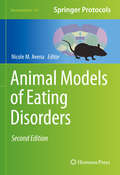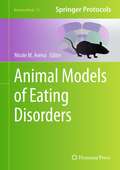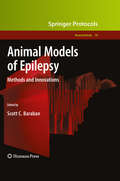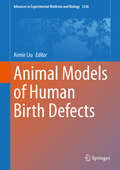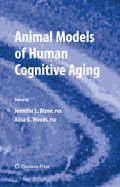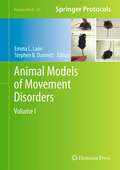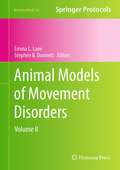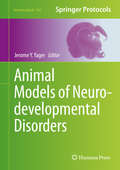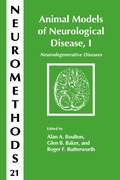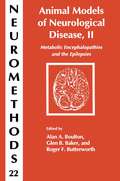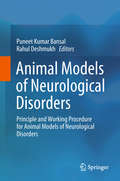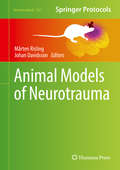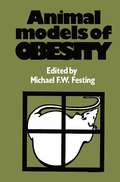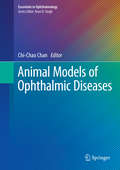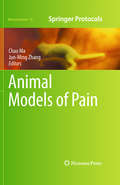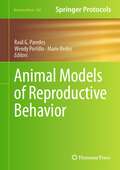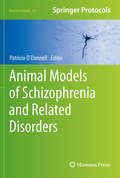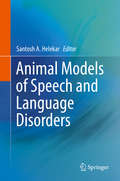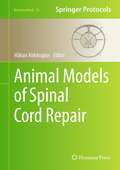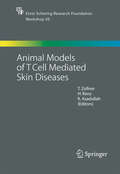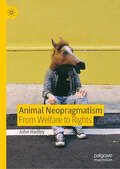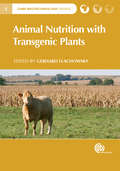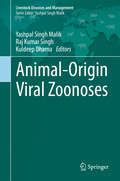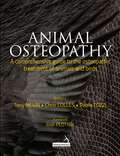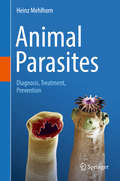- Table View
- List View
Animal Models of Eating Disorders (Neuromethods #161)
by Nicole M. AvenaThis second edition volume expands on the previous edition with discussions on the latest techniques and animal models used to study eating disorders, and the characterizations of behaviors and neurochemical alterations associated with them. Chapters in this book cover different contributing factors of eating disorders and explore topics such as highlight processed food and binge eating; predicting and classifying rates prone to overeating fat; artificial sweeteners in animal models of binge eating; clinical and preclinical bariatric surgery approaches to studying obesity; anorexia and undereating; and food-anticipatory activity in rat models and its underlying mechanisms. In the Neuromethods series style, chapters include the kind of detail and key advice from the specialists needed to get successful results in your laboratory. Cutting-edge and practical, Animal Models of Eating Disorders, Second Edition is a valuable resource for any researchers interested in learning more about this important and developing field.
Animal Models of Eating Disorders (Neuromethods #74)
by Nicole M. AvenaThe growth of the field of eating disorder research has led to a vast array of empirical articles, and the development of new animal models that can be used to study these disorders continues to stimulate new research. Animal Models of Eating Disorders serves as a collection of detailed techniques contributed by experts in the field who are well-versed in the development and implementation of these models. Since eating disorders are complex and likely due to a combination of environmental, genetic, and social causes, the detailed chapters of this volume have been designed to highlight different contributing factors. Collectively, these chapters give a comprehensive and representative overview of both recently developed and classic methodologies used in the study of eating disorders. Written for the popular Neuromethods series, this work contains the kind of thorough description and implementation advice that promises successful results. Authoritative and practical, Animal Models of Eating Disorders aims to aid researchers in the use of animal models to assist in their investigation and characterization of the behaviors and neurochemical alterations associated with these devastating disorders.
Animal Models of Human Birth Defects (Advances in Experimental Medicine and Biology #1236)
by Aimin LiuThis book focuses on the use of animal models to study various human defects. It summarizes our current understanding of a variety of common human birth defects and the essential role of animal models in shedding light on the underlying mechanisms of these disorders. Birth defects are the leading cause of infant deaths, and cost billions of dollars in care for those affected. Unfortunately, the lack of a clear understanding of the mechanisms leading to many of these developmental disorders has hindered effective prevention and early intervention strategies. Studies using animal models have provided essential insights into several human birth defects. This book serves as a valuable reference resource for researchers and graduate students who are interested in learning the basic principles as well as the latest advances in the study of the mechanisms of human birth defects.
Animal Models of Human Cognitive Aging (Aging Medicine)
by Jennifer L. Bizon Alisa WoodsSignificant improvements in lifestyle and medical science are leading to an ever increasing elderly population in the United States and other developed nations. The U.S census bureau estimates that the number of people over 65 will nearly double by 2030, and that the elderly will comprise nearly one-fifth of the world’s entire population within the next 20 years. In Animal Models of Human Cognitive Aging, Jennifer Bizon, Alisa Woods, and a panel of international authorities comprehensively discuss the use of animal models as a tool for understanding cognitive changes associated with the aging process. The book provides substantive background on the newest and most widely used animal models in studies of cognition and aging, while detailing the normal and pathological processes of brain aging of humans in relation to those models. Additional chapters comprehensively review frontal cortical deficits and executive function in primates as related to humans, and the use of transgenic modulation in mice to model Alzheimer’s and other age-related diseases. Groundbreaking and authoritative, Animal Models of Human Cognitive Aging provides a valuable resource for Neuroscientists, Gerontological Scientists and all aging medicine researchers, while serving as a primer for understanding current brain aging studies.
Animal Models of Movement Disorders: Volume I (Neuromethods #61)
by Emma L. Lane and Stephen B. DunnettMovement is the way that animals interact with their environment and is under the organization and complex control of the brain and spinal cord. Multiple central nervous systems, including cortex, basal ganglia, cerebellum, and brainstem, interact to provide precise motor control and integration. Damage or disease within these systems cause profound motor disturbances in man, which can be effectively modeled in animals to develop a better understanding and treatment of the human condition. Animal Models of Movement Disorders introduces a variety of methods and techniques used to model and assess motor function in experimental animals from lower orders, such as drosophila and c. elegans, through vertebrate species including fish, to mammals, such as rodents and non-human primates. The most advanced contemporary models in each system are presented at multiple levels of analysis from molecular and genetic modeling, lesions, anatomy, neurochemistry, to imaging and behavior. Volume I contains general methods of movement disorder assessment as well as an extensive section on dopamine systems. Comprehensive and meticulous, Animal Models of Movement Disorders serves as a valuable reference for those studying motor disorders by covering methodologies in detail and providing the information necessary to consider both the appropriate models and assessment tools that can most informatively answer the key experimental issues in the field.
Animal Models of Movement Disorders: Volume II (Neuromethods #62)
by Emma L. Lane and Stephen B. DunnettMovement is the way that animals interact with their environment and is under the organization and complex control of the brain and spinal cord. Multiple central nervous systems, including cortex, basal ganglia, cerebellum, and brainstem, interact to provide precise motor control and integration. Damage or disease within these systems cause profound motor disturbances in man, which can be effectively modeled in animals to develop a better understanding and treatment of the human condition. Animal Models of Movement Disorders introduces a variety of methods and techniques used to model and assess motor function in experimental animals from lower orders, such as drosophila and c. elegans, through vertebrate species including fish, to mammals, such as rodents and non-human primates. The most advanced contemporary models in each system are presented at multiple levels of analysis from molecular and genetic modeling, lesions, anatomy, neurochemistry, to imaging and behavior. Volume II of this detailed collection contains sections on the basal ganglia, neo- and allo-cortical systems, cerebellar and brain stem systems, as well as spinal cord systems. Comprehensive and meticulous, Animal Models of Movement Disorders serves as a valuable reference for those studying motor disorders by covering methodologies in detail and providing the information necessary to consider both the appropriate models and assessment tools that can most informatively answer the key experimental issues in the field.
Animal Models of Neurodevelopmental Disorders (Neuromethods #104)
by Jerome Y. YagerProviding a spectrum of models that is reflective of the various species that can be utilized in experimentation on disorders across a broad range of developmental disabilities, this volume collects expert contributions involved in investigation of the causes, outcomes, treatment, and prevention. Animal Models of Neurodevelopmental Disorders explores models of perinatal hypoxia-ischemia/cerebral palsy and stroke, autism spectrum disorder, fetal alcohol syndrome, as well as mental retardation. Written in the popular Neuromethods series style, chapters include the kind of detail and key advice from the specialists needed to get successful results in your own laboratory.Practical and authoritative, Animal Models of Neurodevelopmental Disorders serves to introduce and entice those interested in better understanding and treating these disorders to the vital animal model world of investigation.
Animal Models of Neurological Disease, I: Neurodegenerative Diseases (Neuromethods #21)
by Alan A. Boulton, Glen B. Baker and Roger F. Butterworthto the Animal Models Volumes This and several other volumes in the Neuromethods series will describe a number of animal models of neu- psychiatric disorders. Because of increasing public concern over the ethical treatment of animals in research, we felt it incumbent upon us to include this general preface to these volumes in order to indicate why we think further research using animals is necessary and why animal models of psychi- ric and neurologic disorders, in particular, are so important. We recognize that animals should only be used when suitable alternatives are not available. We think it self-e- dent, however, that humans can only be experimented upon in severely proscribed circumstances and alternative pro- dures using cell or tissue culture are inadequate in any models requiring assessments of behavioral change or of complex in vivo processes. However, when the distress, discomfort, or pain to the animals outweighs the anticipated gains for human welfare, then the research is not ethical and should not be carried out.
Animal Models of Neurological Disease, II: Metabolic Encephalopathies and Epilepsies (Neuromethods #22)
by Alan A. Boulton, Glen B. Baker and Roger F. Butterworthto the Animal Models Volumes This and several other volumes in the Neuromethods series will describe a number of animal models of neuropsychiatric disorders. Because of increasing public concern over the ethical treatment of animals in research, we felt it incumbent upon us to include this general preface to these volumes in order to indicate why we think further - search using animals is necessary and why animal models of psychiatric disorders, in particular, are so important. We recognize that animals should only be used when suitable alternatives are not available. We think it self-e- dent, however, that humans can only be experimented upon in severely proscribed circumstances and alternative pro- dures using cell or tissue culture are inadequate in any models requiring assessments of behavioral change or of complex in vivo processes. However, when the distress, discomfort, or pain to the animals outweighs the anticipated gains for human welfare, then the research is not ethical and should not be carried out. It is imperative that each individual researcher examine his/her own research from a critical moral standpoint - fore engaging in it, taking into consideration the animals’ welfare as well as the anticipated gains. Furthermore, once a decision to proceed with research is made, it is the researcher’s responsibility to ensure that the animals’ w- fare is of prime concern in terms of appropriate housing, feeding, and maximum reduction of any uncomfortable or distressing effects of the experimental conditions, and that these conditions undergo frequent formalized monitoring.
Animal Models of Neurological Disorders: Principle and Working Procedure for Animal Models of Neurological Disorders
by Puneet Kumar Bansal Rahul DeshmukhThis book introduces undergraduate, postgraduate and research students and scientists to animal models of neurological disorders, along with their working principle and brief procedures. Addressing all the disorders related to the central nervous system (CNS) in a single platform, on the basis of various literature surveys it describes different procedures to induce a single disease with the help of toxins/chemicals. It also includes numerous protocols for inducing single neurological diseases, thus fulfilling an urgent need for a book that makes specific procedures for neurological disorders available, so that specific disease can be induced in laboratories according to the availability of resources. Further, it acquaints readers with the pathological changes that occur in a particular neurological disorder, which reflect specific signs and symptoms of any particular disease, and examines how they affect everyday life. It is a valuable resource for researchers aiming to eradicate or improve neurological disorders by testing the benefits of different drugs.
Animal Models of Neurotrauma (Neuromethods #149)
by Mårten Risling Johan DavidssonThis volume looks into the need for a variety of experimental models for research on traumatic brain injury (TBI) and peripheral nervous system. It also describes a number of experimental models, such as mechanical devices, that have been developed to model neurotrauma in animal experiments. The overall aim of this book is to explore the variety of models and how they are used in current research. The chapters in this book are organized in four sections and talk about animal models for TBI; animal models for spinal cord or nerve injury; and translational aspects, secondary injuries, in vitro studies, and evaluation of large data sets. In Neuromethods series style, chapters include the kind of detail and key advice from the specialists needed to get successful results in your laboratory.Cutting-edge and comprehensive, Animal Models of Neurotrauma is a valuable resource for researchers interested in expanding their knowledge and research in this developing field.
Animal Models of Ophthalmic Diseases (Essentials in Ophthalmology)
by Chi-Chao ChanThis book describes experimental animal models that mimic common human ocular diseases: herpetic keratitis, cataract, glaucoma, age-related macular degeneration, diabetic retinopathy, uveitis, retinitis pigmentosa, Graves’ disease, and intraocular tumors. In conjunction, these models reflect the diversity and utility of tools used to study human disease. World expert clinicians discuss each model based on their clinical experience and the text is supported by numerous photos and diagrams. In describing the most pertinent animal models of ophthalmic diseases, this book will be of interest to ophthalmologists, vision researchers, fellows, residents and medical students.
Animal Models of Pain (Neuromethods #49)
by Chao Ma and Jun-Ming ZhangWith the loss of work days, the price of health care and payments for compensation, litigation, and malpractice, and the overwhelming cost of human suffering, chronic pain syndromes affect humanity enormously on both an economic and personal level. In Animal Models of Pain, expert investigators in the field provide a consolidated review of the current state of pain research by capturing the diversity of animal models that are used to investigate pain mechanisms, which range from surgical incision to mechanical compression and from spinal cord injury to cutaneous/local inflammation and beyond. As a volume in the respected Neuromethods series, this book delivers its vital content through detailed descriptions of a wide variety of step-by-step laboratory methods. Authoritative and cutting-edge, Animal Models of Pain seeks to lead scientists closer to the ultimate goal of improving the quality of life and relieving the unbearable burden of chronic pain for millions of people throughout the world.
Animal Models of Reproductive Behavior (Neuromethods #200)
by Raúl G. Paredes Wendy Portillo Marie BedosThis volume presents the latest techniques to study several aspects of reproductive behavior in different species. The chapters in this book cover topics such as methods to investigate social behavior; sexual motivation and reward, both of which are fundamental for the initiation of sexual behavior; olfactory signaling; different characteristics and models of reproductive function; and parental behavior in both rats and rabbits. In the Neuromethods series style, chapters include the kind of detail and key advice from the specialists needed to get successful results in your laboratory. Cutting-edge and practical, Animal Models of Reproductive Behavior is a valuable resource for both experienced researchers and students who want to incorporate new techniques into their studies of reproductive behavior.
Animal Models of Schizophrenia and Related Disorders (Neuromethods #59)
by Patricio O'DonnellAnimal models of schizophrenia and other major psychiatric disorders have been sought for decades, and, as a result, we are now facing new vistas on pathophysiology that could lead to novel therapeutic approaches and even hint at possible preventive strategies. Animal Models of Schizophrenia and Related Disorders presents an overview of the information that can be obtained with several different models and a detailed account of how to generate such models in order to ensure that the manipulations used to model schizophrenia-relevant phenomena are used consistently across laboratories. This detailed volume features pharmacological models such as non-competing NMDA antagonists, emphasizing their use in vitro, neurodevelopmental models such as the neonatal ventral hippocampal lesion and the antimitotic MAM, models that reproduce environmental factors such as neonatal hypoxia, vitamin D deficits, and prenatal immune activation, as well as several different genetic model approaches. As a volume in the Neuromethods series, this volume contains the kind of detailed description and implementation advice that is crucial for getting optimal results.Practical and cutting-edge, Animal Models of Schizophrenia and Related Disorders highlights the successes in the use of animal models to gain insight on pathophysiological mechanisms of relevance to major psychiatric disorders in the hope of inspiring investigators to expand the research and test targets that could restore or ameliorate function.
Animal Models of Speech and Language Disorders
by Santosh A. HelekarBasic research over the last decade or two has uncovered similarities between speech, especially its sensori-motor aspects, and vocal communication in several non-human species. The most comprehensive studies so far have been conducted in songbirds. Songbirds offer us a model system to study the interactions between developmental or genetic predispositions and tutor-dependent influences, on the learning of vocal communication. Songbird research has elucidated cellular and molecular mechanisms underlying learning and production of vocal patterns, perception of vocal sounds, vocal motor control and vocal neuromotor plasticity. More recently, the entire genome of the songbird zebra finch has been sequenced. These discoveries, along with the identification of several genes implicated in familial human speech and language disorders, have made it possible to look for analogues of speech and language dysfunction in zebra finches, at least at the perceptual and sensori-motor levels. Two approaches in particular have led us closer to the development of animal models of human speech conditions, namely developmental stuttering and a familial verbal dyspraxia associated with a mutation in the gene for the transcription factor FoxP2. Work on other animals that show developmental sensori-motor learning of vocal sounds used for communication have also shown significant progress, leading to the possibility of development of models of speech and language dysfunction in them. Among mammals, the principal ones include dolphins and whales. In non-human primates, while vocal learning per se is not very prominent, investigations on their communicative abilities have thrown some light on the rudiments of language. These considerations make the publication of a book focused on animal models of speech and language disorders, detailing the overall investigative approach of neurobehavioral studies in animals capable of vocal communication and learned vocalizations, a much-needed and worthwhile project. It would serve as a unifying review of research in this new multidisciplinary frontier, spanning the molecular to the behavioral, for clinicians and researchers, as well as a teaching resource for advanced speech pathology and neuroscience students. This book will also be the first of its kind.
Animal Models of Spinal Cord Repair (Neuromethods #76)
by Håkan AldskogiusThe development of treatment strategies that can help patients with spinal cord injury to regain lost functions and an improved quality of life is a major medical challenge, and experimental spinal cord research has to meet these challenges by resolving fundamental problems, establishing a basis for possible novel treatment strategies of spinal cord injury, and motivating their clinical translation. In Animal Models of Spinal Cord Repair, expert researchers examine a broad range of experimental models for research on spinal cord injury, how they have contributed to our current state of knowledge, and what their advantages are in the further advancement of spinal cord repair. With models from simple lamprey to non-human primates, the information presented is intended to guide the implementation of animal models for spinal cord repair as well as to raise the awareness of the relevance of experimental models which may not be in the current mainstream of this research. As a part of the Neuromethods series, this work contains the kind of detailed description and implementation advice to guarantee successful results in the laboratory. Comprehensive and cutting-edge, Animal Models of Spinal Cord Repair presents the background information and hands-on methods descriptions, as well as the basic and clinical issues, needed to stimulate and guide researchers with different backgrounds towards the development of improved strategies for functionally relevant repair of the injured human spinal cord.
Animal Models of T Cell-Mediated Skin Diseases (Ernst Schering Foundation Symposium Proceedings #50)
by T. Zollner Harald Renz Khusru AsadullahPharmaceutical companies are spending increasing amounts of money on drug discovery and development. Nevertheless, attrition rates in clinical development are still very high, and up to 90% of new compounds fail in clinical phase I - III trials, which is partially due to lack of clinical efficacy. This indicates a strong need for highly predictive in vitro and in vivo models. The "50th International Workshop of the Ernst Schering Research Foundation" focussed on "Animal Models of T Cell-Mediated Skin Diseases". Such animal models should have impact not only on inflammatory dermatoses but also on other inflammatory disorders due to their model character. The current volume summarises recent advances in animal research that are important for anti-inflammatory drug discovery.
Animal Neopragmatism: From Welfare to Rights
by John HadleyThis book affords a neopragmatic theory of animal ethics, taking its lead from American Pragmatism to place language at the centre of philosophical analysis. Following a method traceable to Dewey, Wittgenstein and Rorty, Hadley argues that many enduring puzzles about human interactions with animals can be ‘dissolved’ by understanding why people use terms like dignity, respect, naturalness, and inherent value. Hadley shifts the debate about animal welfare and rights from its current focus upon contentious claims about value and animal mindedness, to the vocabulary people use to express their concern for the suffering and lives of animals. With its emphasis on public concern for animals, animal neopragmatism is a uniquely progressive and democratic theory of animal ethics.
Animal Nutrition with Transgenic Plants (CABI Biotechnology Series)
by Marc De Loose Yi Liu Thomas Frenzel Agnes Ricroch Ralf Einspanier Atte Von Wright Emilio Rodriguez-Cerezo Jie Wen Matin Qaim Joachim Scholderer Tj Higgins Klaus Ammann* Gathers together more than 150 feeding studies with food-producing animals and covers both first and second generation transgenic plants * The first central resource of this information for researchers, students and policy makers * Includes contributions from a wide range of specialists in the field
Animal-Origin Viral Zoonoses (Livestock Diseases and Management)
by Yashpal Singh Malik Raj Kumar Singh Kuldeep DhamaThis book is the second volume in the series Livestock Diseases and Management, and reviews the importance and implications of animal origin viral zoonoses. It also highlights the specific etiology and epidemiology of these viral infections and discusses their various biological and mechanical transmission mechanisms. Further, the book reviews various measures for controlling viral zoonoses and examines novel therapeutic and prophylactic strategies.Discussing recent studies on the pathogenesis and host immune response to these infections, it underscores the importance of using vaccines against these viral diseases to reduce the risk of them being transmitted to humans.Lastly, it describes in detail the challenges posed by these viral infections and our readiness to face them.
Animal Osteopathy: A Comprehensive Guide to the Osteopathic Treatment of Animals and Birds
by Christopher Colles Anthony Nevin Paolo TozziThis is a comprehensive reference textbook for all those using osteopathic treatment techniques with animals or birds or studying to do so. The book is divided into sections: equine osteopathy; general small animal osteopathy; osteopathy for exotics- (pets such as tortoise, snakes, ferrets etc); osteopathy for wildlife - native as well as non to the UK including species found in most zoological collections; avian osteopathy - both domestic and wild/exotic. Each section covers information specific to that group. This makes the book appropriate for supporting structured post-graduate university validated courses in a clear and easily navigable way.Content includes detailed sections on the differences encountered when working with animals; health and safety around different species; working within the law; integrating with allied professions; anatomy; physiology and patho-physiology; neurology; orthopaedics; differential diagnosis; differential aetiology of presenting conditions when compared to the human model; supportive husbandry and rehabilitation methods.It includes sections covering approaches to patient care; specifics of taking a detailed case history; use of supporting diagnostics; observation; palpation; structuring a treatment programme suitable for each species. Osteopathic treatment techniques and physical patient contact methods are be explained as well as graphically illustrated. All chapters are fully referenced and include revision notes to act as guidelines for the reader.It is intended primarily for post-graduate osteopaths intending to work with animals or who are already doing so. It will also strongly appeal to vets as well as to other allied professions working with animals (eg massage therapists).
Animal Parasites: Diagnosis, Treatment, Prevention
by Heinz MehlhornThis textbook focuses on the most important parasites affecting dogs, cats, ruminants, horses, pigs, rabbits, rodents, birds, fishes, reptiles and bees. For each parasite, the book offers a concise summary including its distribution, epidemiology, lifecycle, morphology, clinical manifestations, diagnosis, prophylaxis and therapeutic measures. Numerous informative tables and more than 500 color micrographs and schemes present the most important aspects of the parasites, their induced diseases and the latest information on suitable prevention and control measures. 100 questions at the end of the book offer readers the chance to test their comprehension. The book is well suited as both a textbook and a reference guide for veterinarians, students of the veterinary and life sciences, veterinarian nurses, laboratory staff, and pet and livestock owners.
